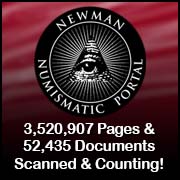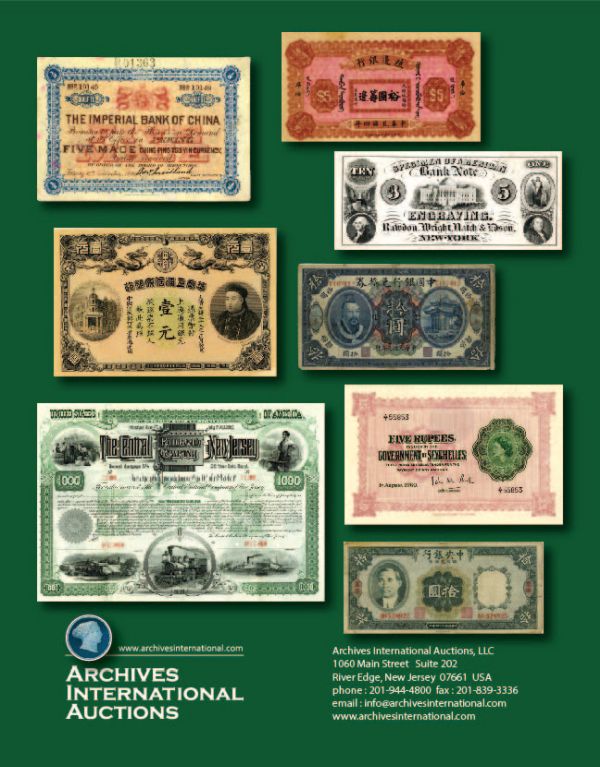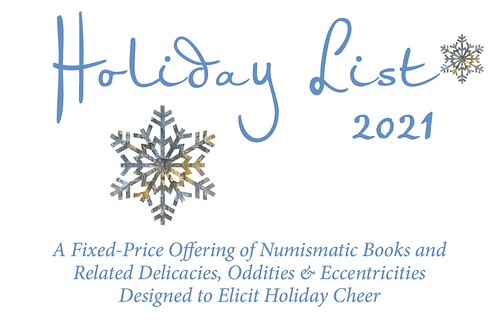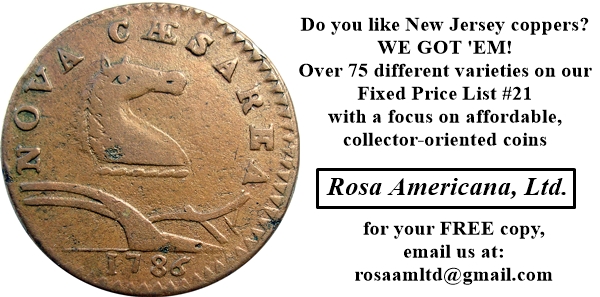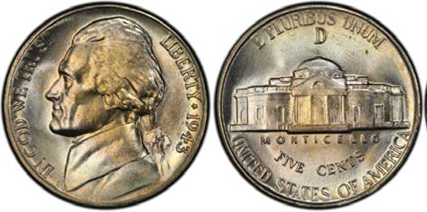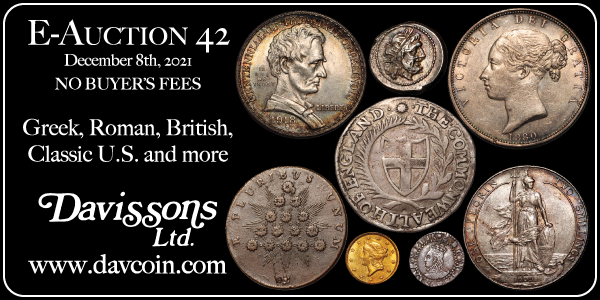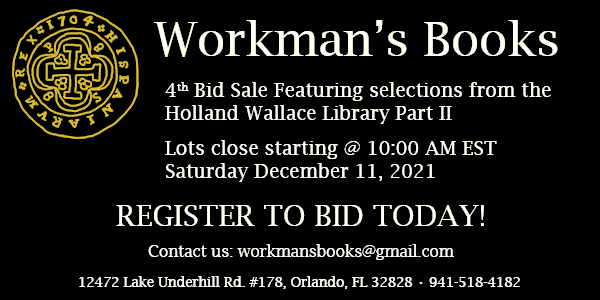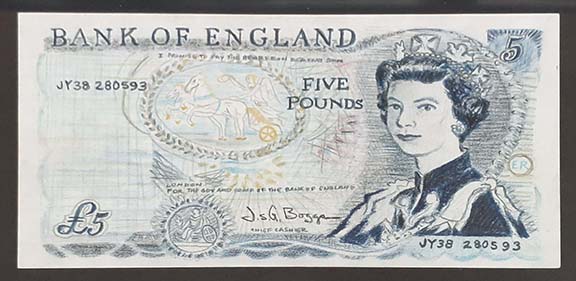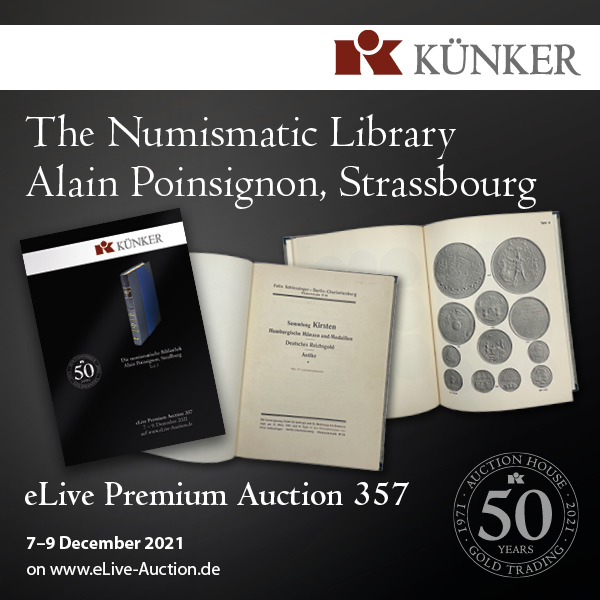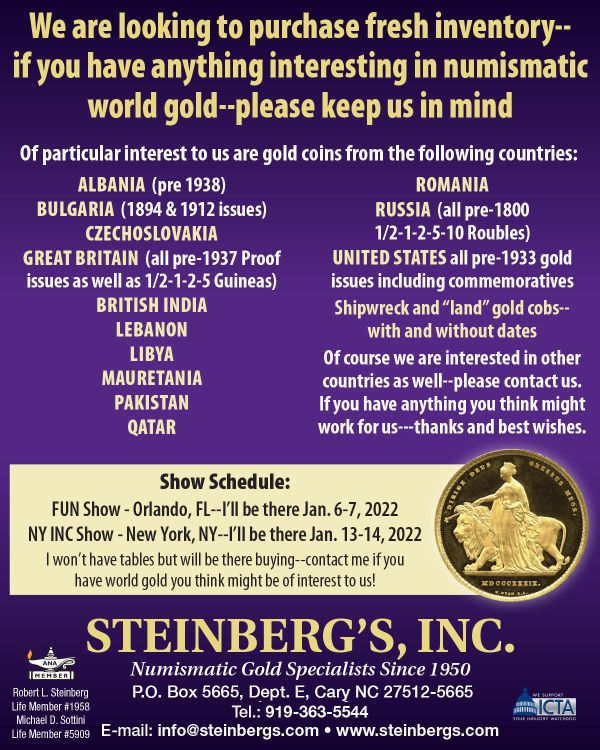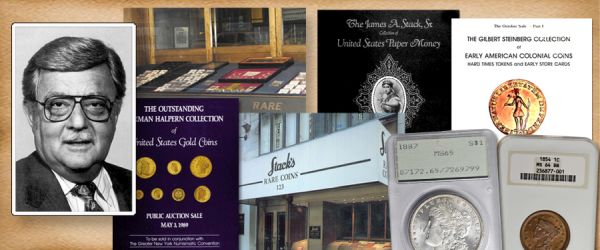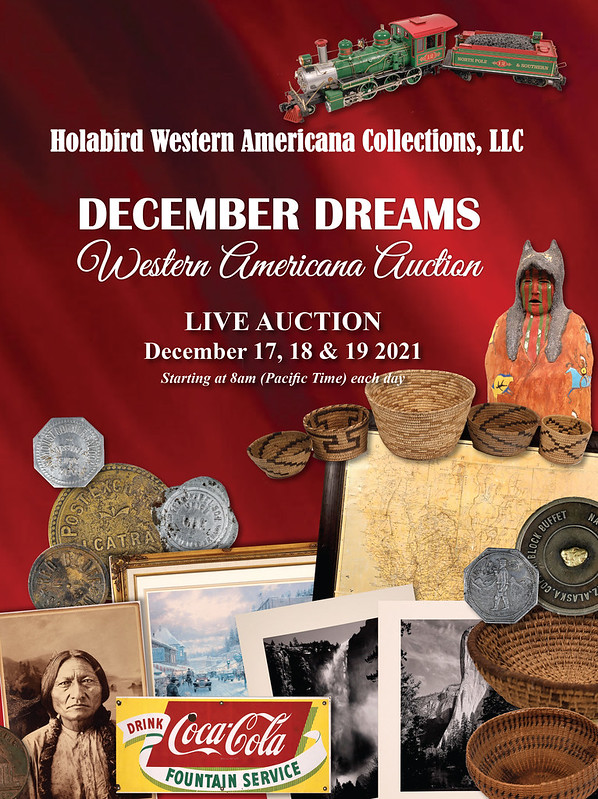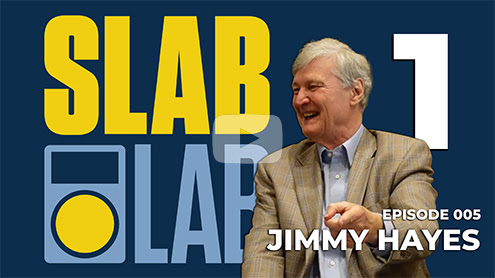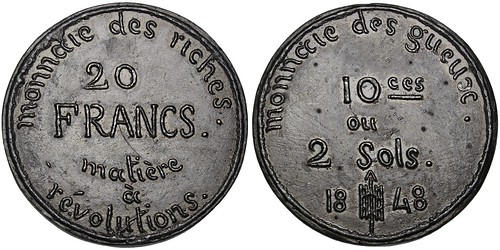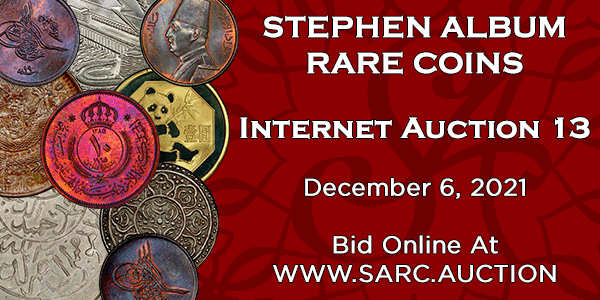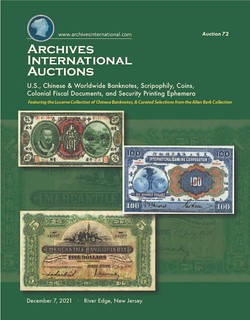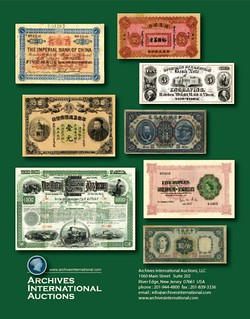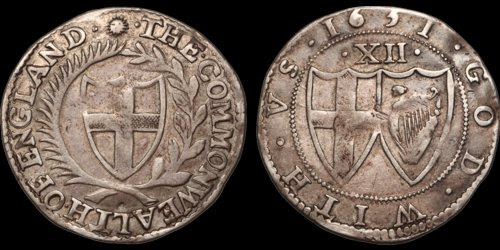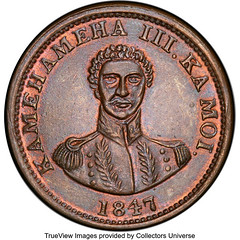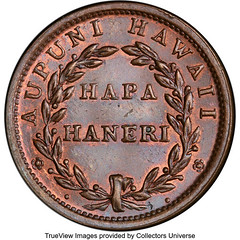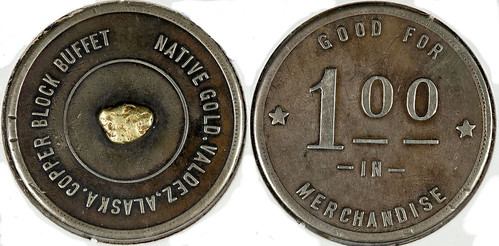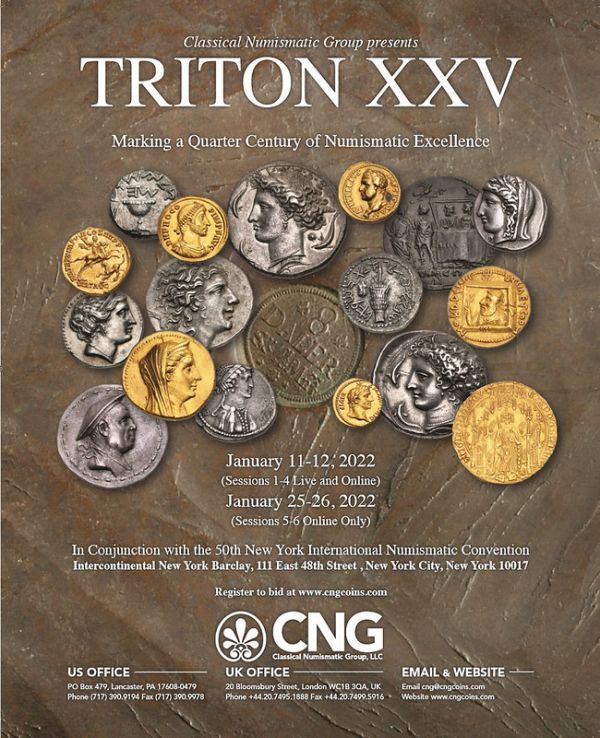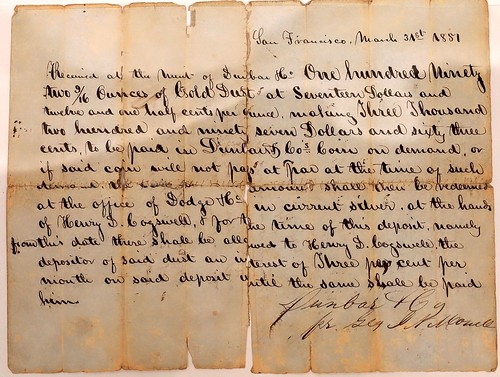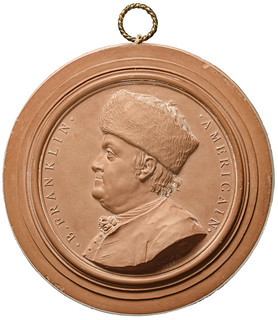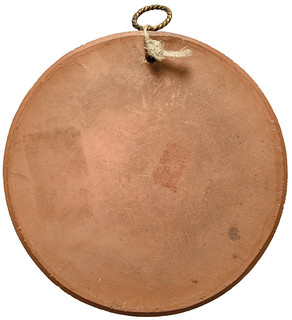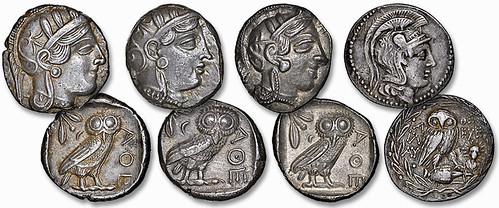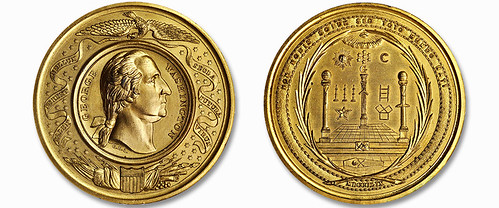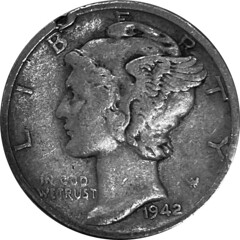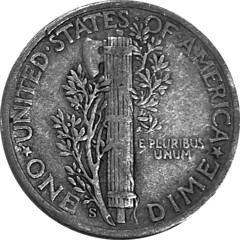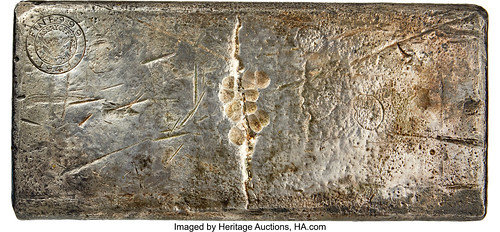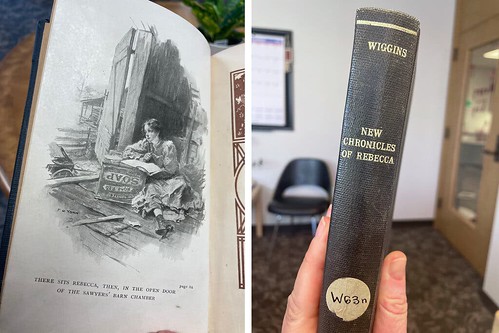
Visit our NBS Sponsors


About UsThe Numismatic Bibliomania Society is a non-profit association devoted to the study and enjoyment of numismatic literature. For more information please see our web site at coinbooks.org SubscriptionsThose wishing to become new E-Sylum subscribers (or wishing to Unsubscribe) can go to the following web page link MembershipThere is a membership application available on the web site Membership Application To join, print the application and return it with your check to the address printed on the application. Print/Digital membership is $40 to addresses in the U.S., and $60 elsewhere. A digital-only membership is available for $25. For those without web access, write to: Charles Heck, Treasurer AsylumFor Asylum mailing address changes and other membership questions, contact Chuck at this email address: treasurer@coinbooks.org SubmissionsTo submit items for publication in The E-Sylum, write to the Editor at this address: whomren@gmail.com BUY THE BOOK BEFORE THE COINSale CalendarWatch here for updates! |
- WAYNE'S WORDS: THE E-SYLUM DECEMBER 5, 2021
- KOLBE & FANNING'S 2021 HOLIDAY LIST
- WORKMAN BOOKS DECEMBER 11, 2021 SELECTIONS
- NEW BOOK: CATALOGUE DES MONNAIES AMÉRICAINES
- NEW BOOK: THURINGIAN FOREST NOTGELD
- NEW BOOK: TRADE TOKENS OF QUINCY, WASHINGTON
- COLLECTING NICKELS FROM CIRCULATION IN 2019
- VIDEO: RICK AMOS AND COIN WORLD+
- NOTES FROM E-SYLUM READERS: DECEMBER 5, 2021
- WHITMAN SHIELD NICKEL COIN BOARD 3RD EDITION
- BRITISH MUSEUM BOGGS OLD BAILEY NOTE IMAGES
- VOCABULARY TERM: GILDING, GILT
- ROBERT HEPWORTH LLOYD (1906-2009)
- HARVEY STACK'S NUMISMATIC FAMILY, PART 110
- VIDEO: PCGS SLAB LAB
- NUMISMAGRAM SELECTIONS: DECEMBER 2021
- STEPHEN ALBUM INTERNET AUCTION 13
- ARCHIVES INTERNATIONAL AUCTION 72
- DAVISSON'S E-AUCTION 42 BRITISH
- HERITAGE BIG ISLAND HAWAIIAN SALE SELECTIONS
- HOLABIRD AMERICANA DECEMBER 2021 HIGHLIGHTS
- MINT LETTER OF DUNBAR GOLD DEPOSIT
- NUMISMATIC NUGGETS: DECEMBER 5, 2021
- ATHENS: HOME OF THE WISE OWL
- FINANCING SULLA'S RECONQUEST OF ITALY
- THE RISE OF SILVER COINAGE
- GILT NON NOBIS SOLUM WASHINGTON MEDAL
- MODERN HOBO NICKELS AND TOKENS
- THE ERRORS ARE STILL OUT THERE
- THOUSAND-OUNCE SILVER ASSAY OFFICE INGOT
- QUARTER SHORTAGE IN SEATTLE
- LOOSE CHANGE: DECEMBER 5, 2021
Click here to read the thin version on the web
Click here to subscribe
Click here to access the complete archive
To comment or submit articles, reply to whomren@gmail.com
Content presented in The E-Sylum is not necessarily researched or independently fact-checked, and views expressed do not necessarily represent those of the Numismatic Bibliomania Society.
WAYNE'S WORDS: THE E-SYLUM DECEMBER 5, 2021
 No new subscribers this week. We now have 6,721 subscribers.
No new subscribers this week. We now have 6,721 subscribers.
Thank you for reading The E-Sylum. If you enjoy it, please send me the email addresses of friends you think may enjoy it as well and I'll send them a subscription. Contact me at whomren@gmail.com anytime regarding your subscription, or questions, comments or suggestions about our content.
This week we open with two numismatic literature sales, three new books, updates from the Newman Numismatic Portal, notes from readers, and more.
Other topics this week include notgeld, trade tokens, coin boards, money artist J.S.G. Boggs, the longest standing member of the ANA, another TON of auction previews, ancient silver coinage, Hobo nickels, error coins, and one massive silver ingot.
To learn more about the coins of Japan and Bolivia, Mint Director reports, a new book on North American colonial coins, Jefferson Nickels, Mother coins, sunken Yap stones, the Florin Street Band, Jimmy Hayes, Sancho IV, the Imperial Bank of China, Hawaiian coinage, pioneer gold controversy and Coinless in Seattle, read on. Have a great week, everyone!
Wayne Homren
Editor, The E-Sylum
KOLBE & FANNING'S 2021 HOLIDAY LIST
Kolbe & Fanning have issued their 2021 Holiday List of numismatic literature. Explore! -Editor
WORKMAN BOOKS DECEMBER 11, 2021 SELECTIONS
Alan Workman's fourth literature sale closes December 11, 2021. Here are some additional lot selections. -Editor
Workman's Books fourth bid sale is underway and there is less than a week left to get registered to bid! The sale includes many rare, vintage, and out-of-print numismatic books, auction catalogs, dealer fixed price lists, and numismatic journals from the collection of long-time dealer, collector, and author, Holland Wallace. The sale closes at 10:00 AM on December 11, 2021 and includes 612 lots of rarely seen items on the United States, Canada, Mexico, Central & South America, Europe, Portugal, Spain, the Middle East, Asia, and Spanish colonial numismatics. Included in this sale are important works and sales by Barriga-Villalba, Bruns, Burzio, Calico, Cayon, Christie's, Christensen, Craig, Douglas, Elder, Gilboy, Glendining, Grove, Herrera, Lazaro, Low, Medina, Ponterio, Pradeau, Pridmore, Prober, Schulman, Sellschopp, Shuhart, Sotheby's, Stack's, Superior, Woodward, and many others.
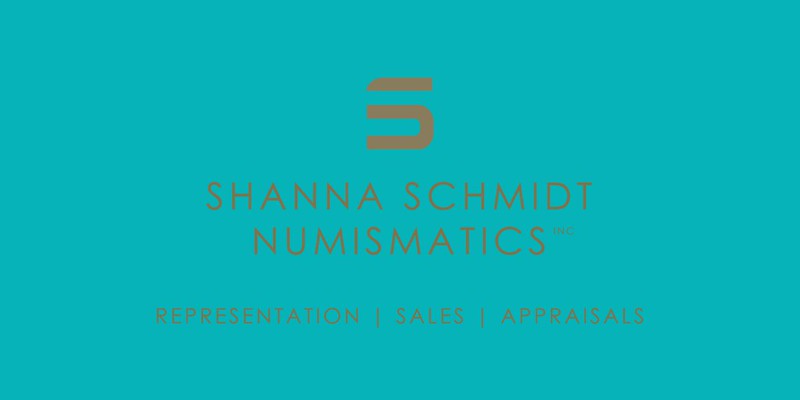
NEW BOOK: CATALOGUE DES MONNAIES AMÉRICAINES
Jerome Jambu is a former curator at the Department of Coins and Medals at France's Biblioteque Nationale. His new book examines coins minted for the Americas. He recently published "The Coins Made "for the Islands and Mainland of America" by the French West India Company (1670)" in the June 2021 issue of The Journal of American Numismatics (JEAN). Here is a Google-translated description from the publisher's website. -Editor
CATALOG OF AMERICAN COINS
VOLUME 1: NORTH AMERICA, COLONIAL COINS, COINS FROM THE WEST INDIES
Jerome Jambu
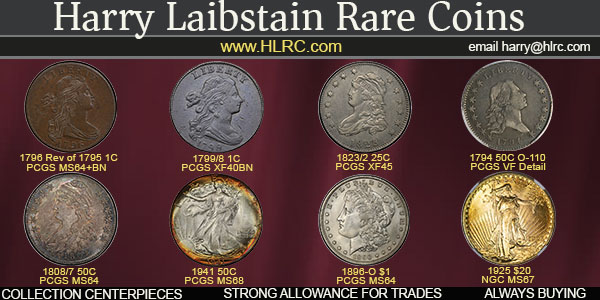
NEW BOOK: THURINGIAN FOREST NOTGELD
A new book on notgeld of the Thuringian Forest has been published. Here is a Google-translated version of an article in German by Hans-Ludwig Grabowski in Geldscheine Online. -Editor
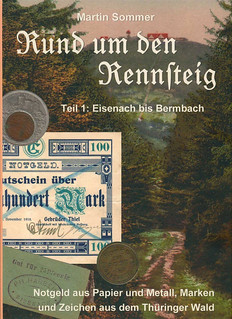 Martin Sommer:
Martin Sommer:
Around the Rennsteig
Part 1: Eisenach to Bermbach
Emergency money made of paper and metal, brands and symbols from the Thuringian Forest
316 pages, illustrated in color throughout, format 21 cm x 29.7 cm, hardcover, Kremmen, 2021.
Price: 28.00 euros + 5.00 euros shipping.
The thought of a kind of numismatic travel guide, a guide for emergency money and home collectors or a regional catalog had not let go of the author for several years. Inspired and motivated by other regional catalogs published in recent years, he decided in summer 2018 to prepare the pieces he had collected over the years. Together with another collector, he brought a real Thuringian on board, from whose collection many of the items shown come from.

NEW BOOK: TRADE TOKENS OF QUINCY, WASHINGTON
All politics is local they say. And much of numismatics is local, too. Adrián González-Salinas owns copy # 28 of this new booklet on the trade tokens of Quincy, Washington, and he passed along this information for our readers. Thank you. -Editor
Trade Tokens, Good Fors and Rain Checks of Quincy, Washington
(Little Time Travelers from 120 Years of Small Town History)

COLLECTING NICKELS FROM CIRCULATION IN 2019
A new addition to the Newman Numismatic Portal is the latest issue of the Central Ohio Numismatic Association Newsletter. Project Coordinator Len Augsburger provided the following report. -Editor
Collecting Jefferson Nickels From Circulation in 2019
Recently added to Newman Portal is the October 2021 issue of the Central Ohio Numismatic Association (CONA) newsletter. CONA member Bill Kamb contributed an article on collecting Jefferson nickels from pocket change. Kamb sets the scene, I was pleasantly surprised in the summer of 2019 when our daughter, who lives in Atlanta with her family, announced that our grandson, Easton, might be interested in coin collecting. He was 6 years old at the time. When we went there for Thanksgiving, I brought some Whitman penny and nickel books and got a few rolls of each from a bank for us to search. We had a great time and it brought back memories of when I started collecting as a kid in the late ‘50s.

VIDEO: RICK AMOS AND COIN WORLD+
These are selections from the David Lisot Video Library that feature news and personalities from the world of coin collecting. David has been attending coin conventions since 1972 and began videotaping in 1985. The Newman Numismatic Portal now lists all David's videos on their website at:
https://nnp.wustl.edu/library/multimediadetail/522852
Here's one with Coin World owner Rick Amos about their Coin World+ product. -Editor
Amos Media Company Releases Coin World+
for Coin Collectors.
VIDEO: 9:49.
Rick Amos, CEO, Amos Media Company
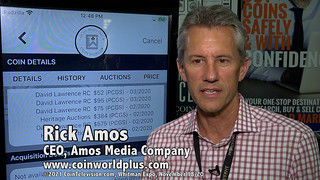 The owner of Coin World, Rick Amos, shares the latest digital development for coin collectors. The new app offers many benefits such as Coin World+ tagged coins being worth a premium due to the tag applied to them and the technology behind them. The value the tags represent makes tagged coins stand apart.
The owner of Coin World, Rick Amos, shares the latest digital development for coin collectors. The new app offers many benefits such as Coin World+ tagged coins being worth a premium due to the tag applied to them and the technology behind them. The value the tags represent makes tagged coins stand apart.
An excerpt of the video is available for viewing on the Coin Television YouTube Channel at:
https://youtu.be/KOW3e7agOEs
NOTES FROM E-SYLUM READERS: DECEMBER 5, 2021
Q. David Bowers' Numismatist Column Ends
Dave Lange writes:
"I concur that the conclusion of Q. David Bowers' column in The Numismatist is a sad milestone, but I eagerly await publication of his autobiography, My Life in Rare Coins: And Other Adventures. It's been saved on my Amazon Wish List since last year but appears to have been delayed, perhaps by the pandemic."
To read the earlier E-Sylum article, see:
PIGGYBANK FULL OF 1826 LARGE CENTS
(https://www.coinbooks.org/v24/esylum_v24n48a29.html)
Other topics this week include Nickel Silver, ACSearch, Mother Coins, and Yap Stones. -Editor
WHITMAN SHIELD NICKEL COIN BOARD 3RD EDITION
In the Winter 2022 issue of his Coin Board News, author and researcher Dave Lange published a new discovery in the Whitman coin board series. With permission, here is the article. Thanks. -Editor
MAJOR DISCOVERY!
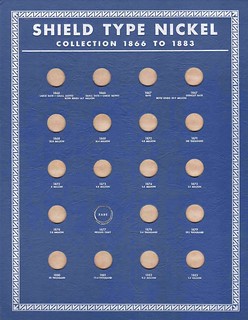 Your eyes do not deceive you—Yes, that's a Third
Edition Whitman board for Shield Nickels! This title
was unknown in the Third Edition when I published
my book in 2007, but it seemed that it should have
been produced, so I included place-holder listings for
such a board with either clothlike or leatherette paper.
Since that time I'd pretty much resigned myself to the
fact that it would never be found, but now I am the
owner of the only example known to me.
Your eyes do not deceive you—Yes, that's a Third
Edition Whitman board for Shield Nickels! This title
was unknown in the Third Edition when I published
my book in 2007, but it seemed that it should have
been produced, so I included place-holder listings for
such a board with either clothlike or leatherette paper.
Since that time I'd pretty much resigned myself to the
fact that it would never be found, but now I am the
owner of the only example known to me.
This surfaced in a group lot of Third Edition boards being sold by a small, online auction company I hadn't heard of before, and I was completely unaware of this opportunity until I was tipped off by a fellow board enthusiast. Mike Nixon's interest is primarily in filling boards with coins for the purpose of framing and displaying them, and he's drawn to the Kent and First Edition Whitman boards. Thus, he suggested I'd be a more likely buyer for this lot.

BRITISH MUSEUM BOGGS OLD BAILEY NOTE IMAGES
Tom Hockenhull of the British Museum kindly provided images of their 5 pound J.S.G. Boggs bill that was an exhibit in his trial at Old Bailey. Thanks! Copyright Trustees of the British Museum. -Editor
VOCABULARY TERM: GILDING, GILT
Another article in this issue discusses the gilt Non Nobis Solum Washington medal. Here's an entry from Dick Johnson's Encyclopedia of Coin and Medal Terminology about gilding. -Editor
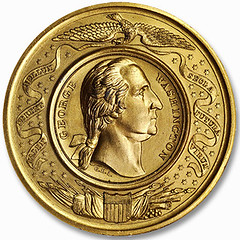 Gilding, Gilt.
Covered with gold; the application of gold to an object by any process. Gilding must use some form of gold to overlay, it cannot be gold color alone; the purpose is to give an object of any base metal the desirable qualities, allure and color of a gold surface. Obviously goldplating – by electrodeposition – is a major process of applying a fine layer of gold to a surface, but this has been in use only since about 1840s. Previously gold was applied by firegilding and by the use of gold leaf (both since antiquity).
Gilding, Gilt.
Covered with gold; the application of gold to an object by any process. Gilding must use some form of gold to overlay, it cannot be gold color alone; the purpose is to give an object of any base metal the desirable qualities, allure and color of a gold surface. Obviously goldplating – by electrodeposition – is a major process of applying a fine layer of gold to a surface, but this has been in use only since about 1840s. Previously gold was applied by firegilding and by the use of gold leaf (both since antiquity).
ROBERT HEPWORTH LLOYD (1906-2009)
American Numismatic Biographies author Pete Smith submitted this article on the Longest Standing Member of the ANA. Thanks! First, here's the reader who correctly answered Pete's question from last week. -Editor
HARVEY STACK'S NUMISMATIC FAMILY, PART 110
The latest article in Harvey Stack's blog series discusses the state of the coin market in 1991. Thanks, Harvey. -Editor
?In 1991 the numismatic hobby really started to grow again, after years recovering from Black Monday in October 1987, when the market dropped about 20%. However, collectibles were able to hold steady in the market, as collectors and investors who had the extra money could purchase such items as a sign of wealth and a store of value.?
VIDEO: PCGS SLAB LAB
The Slab Lab video series from PCGS features interviews with prominent collectors and dealers. First up was a three-part series with Jim Halperin of Heritage, and the latest is the first of a series with the legendary Jimmy Hayes. Here's a handy guide to the episodes, hosted by Seth Chandler of Witter Coins. -Editor

NUMISMAGRAM SELECTIONS: DECEMBER 2021
Numismagram's Jeremy Bostwick passed along these highlights from the most recent addition of new material to his website at the beginning of the month. This upload is particularly strong in French and Swedish art medals, with a few seasonally-appropriate items sprinkled in as well. For all of his new medals and tokens, please visit numismagram.com/inventory. -Editor
101821 | FRANCE. Revolution/Satirical tin Medal. Issued 1848 (38mm, 37.22 g, 12h). "monnaie des riches / 20 / FRANCS / matière / à / révolutions" (money of rich—20 francs—a cause for revolution) in six lines / "monnaie des gueux / 10ces / ou / 2 sols" (money of the beggars—10 centimes or 2 sols) in four lines; below, spear surrounded by bundle of rods and dividing date. Edge: Plain. Collignon 1054 bis; Paris Musées (Carnavalet), no. ND9109. Choice Mint State. Deep gray surfaces, with sharp, clear detail; great quality for this rare and interesting type. $395.
Part of the wave of revolutions across Europe in 1848, the 1848 French Revolution saw the end of the July Monarchy (1830-1848) and the creation of the short-lived Second French Republic (1848-1852). During this revolution, numerous medals were produced satirizing the various contemporaneous events. In the case of the present specimen, the vast inequality between the rich and poor is stressed, with there being some 200 10 centimes to constitute one 20 francs piece.

STEPHEN ALBUM INTERNET AUCTION 13
Here's the announcement for the December 2021 E-Auction 13 sale from Stephen Album Rare Coins. Some interesting pieces. -Editor
Stephen Album Rare coins will hold its Internet Auction 13 at its offices in Santa Rosa, California on December 6, 2021. Internet pre-bidding has begun and can be accessed through their website. The Auction is made up of an even 500 lots of PCGS-certified world coins.
There are many affordable coins in the sale, and a few notable sections which include:
- Over 100 Lots From Egypt (Ottoman and Kingdom)
- A Collection of Tibetan Tangkas
- A Nice Selection of Crown-Sized Yemeni Riyals
- 71 Lots of German Coins From Many Time Periods
ARCHIVES INTERNATIONAL AUCTION 72
Here's the press release for the Archives International Auction 72, closing on December 7, 2021. Great material, as usual. -Editor
ARCHIVES INTERNATIONAL AUCTIONS OFFERS HISTORIC CHINESE & WORLD BANKNOTE COLLECTION ON DECEMBER 7, 2021.
The auction will be held by Archives International Auctions at their offices in River Edge, N.J.
DAVISSON'S E-AUCTION 42 BRITISH
In an email to clients on December 3, 2021, Lief Davisson published this overview of British coins and tokens in the Davissons upcoming auction. -Editor
E-Auction 42 closes next week! Bidding closes on Wednesday, December 8th beginning at 10 a.m. U.S. Central Time. Read on as we survey a few of the more notable British coins and tokens we have on offer.

HERITAGE BIG ISLAND HAWAIIAN SALE SELECTIONS
Here are some highlights from the December 16-19, 2021 Heritage sale of The Big Island Collection of Hawaiian Coinage and Tokens. I'd never seen some of these pieces. -Editor
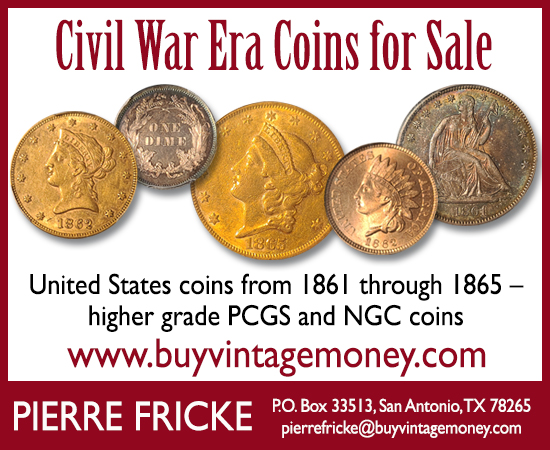
HOLABIRD AMERICANA DECEMBER 2021 HIGHLIGHTS
Here are some rare token highlights from the December 17-19 Holabird Premier Americana Auction. -Editor
MINT LETTER OF DUNBAR GOLD DEPOSIT
A great item of numismatic history in the December Holabird sale is this 1851 letter relating to pioneer gold. -Editor
THE BOOK BAZARRE
NUMISMATIC NUGGETS: DECEMBER 5, 2021
Here's a selection of interesting or unusual items I came across in the marketplace this week. Tell us what you think of some of these. -Editor
1777-Dated Revolutionary War Period, Benjamin Franklin Portrait Terra Cotta Medallion Plaque, shown wearing his popular American Beaver Fur Hat, by Jean-Baptiste Nini, Choice Near Mint.
Large size 4.5 diameter (113 mm) high-relief Portrait Medallion of Benjamin Franklin in Terra Cotta (a fired ceramic clay). Produced in France by sculptor, Jean-Baptiste Nini during the height of Franklin's popularity with the French nation. Nini made a small variety of Franklin portrait medallions in Terra Cotta for sale in both France and America. This variety shows Franklin wearing his famous Beaver Fur Hat with the inscription B. Franklin - Americain.
Nini has signed and dated within the text located on the truncation of Franklin's bust with NINI - 1777
. The 2005 John Ford Jr. Collection Auction Sale contained two similar Terra Cotta Plaques by Nini. One in very choice condition sold for $5,750 and one in lower quality sold for $3,220. This current Nini
Medallion is of museum quality, having excellent eye appeal for display, near Mint having some minor nicks on the outer rim edge. The top rim has a small metal ring attached to a piece of twine to hang on display. A nice example of this historic, contemporarily produced, Revolutionary War period French tribute to Benjamin Franklin. In France as America's foremost ambassador and statesman to the King and his court.
A classic from the December 11, 2021 Early American auction. -Editor
To read the complete lot description, see:
1777 Benjamin Franklin Terra Cotta Medallion By Nini
Variety Franklin Wearing His American Beaver Fur Hat
(https://www.earlyamerican.com/Auctions/ClientPages/lots.item.php?auction=10&customerid=3683&source=email.2021.10.06&lot=118)
Other topics this week include an 1898 Proof Double Eagle, a James Buchanan Inaugural medal, a Purple Heart, and a Japan Imperial National Bank 2 Yen banknote. -Editor

ATHENS: HOME OF THE WISE OWL
In a blog post, Stack's Bowers Numismatist Nicholas Fritz discusses the history of the great city behind the classic Athenian Owl coins. Here's an excerpt - see the complete article online. -Editor
No ancient Greek city state can capture the modern imagination quite like Athens. Though the whole of the ancient Greek world is known as "the cradle of Western Civilization," it is Athens that has come to symbolize the fullest fruition of reason and democracy in the ancient world. The legacy of the Athenian Polis lives on, in both tangible artifacts like coins, and the intangible heritage of critical reasoning and the questioning of assumptions.

FINANCING SULLA'S RECONQUEST OF ITALY
In a pair of blog articles Lucia Carbone of the American Numismatic Society presents her studies on "Financing Sulla's Reconquest of Italy." -Editor
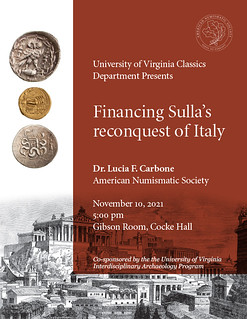 Appian states that Sulla had at his disposal an army of 40,000 men, including five legions of Roman infantry, 6,000 knights, plus Greek and Macedonian auxilia. According to M. Speidel's calculations, this would imply that Sulla needed to have at his disposal the equivalent of almost 10 million denarii. Since Sulla was barred from taking advantage of the enhanced monetary production of the Roman mint, it becomes clear that he must have taken advantage of the bullion supplied by his recent victories in the East.
Appian states that Sulla had at his disposal an army of 40,000 men, including five legions of Roman infantry, 6,000 knights, plus Greek and Macedonian auxilia. According to M. Speidel's calculations, this would imply that Sulla needed to have at his disposal the equivalent of almost 10 million denarii. Since Sulla was barred from taking advantage of the enhanced monetary production of the Roman mint, it becomes clear that he must have taken advantage of the bullion supplied by his recent victories in the East.
The monetary production of the collegium of triumviri monetales of 83–82 BCE, composed by P. Crepusius, C. Mamilius Limetanus (RRC 362/1) and L. Marcius Censorinus have been the object of foundational die studies that provided a model for future ones. Back in 1976, T. Buttrey published a fundamental study of Crepusius' issues. Schaefer's archive provided the material for the study of the issues of L. Marcius Censorinus and C.Mamilius Limetanus. The importance of these issues does not only reside in the historical moment they produced in, but also in their technical peculiarities.

THE RISE OF SILVER COINAGE
Chip Howell passed along this article from The Ancient Near East Today. Thanks. -Editor
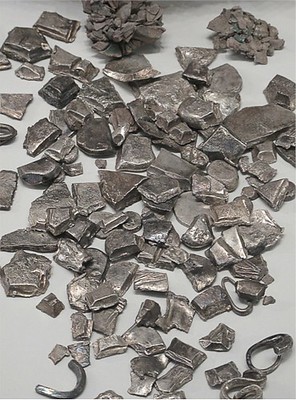 Why was money invented? The question is seldom asked nowadays because money is all-pervasive in modern developed economies, but this was not always the case.
Why was money invented? The question is seldom asked nowadays because money is all-pervasive in modern developed economies, but this was not always the case.
The traditional answer to why money was invented is based on Aristotle's contention in his Nicomachean Ethics that it was a development from barter, leading to his oft-quoted formulation that ‘money is the measure of everything'. In other words, money was useful because it was a universal denominator but also, it was a virtually imperishable, easily portable, readily exchangeable store of wealth.
A sophisticated ‘commodity exchange' was used in the great Eastern and Egyptian empires in which silver was valued against wheat, dates, figs, olives, copper, gold and other commodities. Silver was extracted in Western Asia from the fourth millennium BCE and used extensively in the form of Hacksilber (lumps of silver, often chopped up jewellery). There is an argument in the literature as to whether this constituted a form of proto money, but thorough investigation of Hacksilber hoards in the southern Levant combined with elemental compositional analysis has shown that the weights and composition of the silver are too variable to have been used as coinage.

GILT NON NOBIS SOLUM WASHINGTON MEDAL
Stacks Bowers Director of Consignments and Numismatics James McCartney published a blog article about the gorgeous gilt Non Nobis Solum Washington medal in their December 2021 Tokens & Medals sale. -Editor
We are excited to offer a beautiful MS-65 (NGC) ca. 1859 Non Nobis Solum Washington medal in gilt white metal in lot 70033 of our December 2021 Tokens and Medals Collectors Choice Online Auction. Sharply struck with beautiful satin surfaces and no significant abrasions, this piece is an important offering for specialists in Washington medals or Masonic pieces.

MODERN HOBO NICKELS AND TOKENS
Here are a couple items that caught my eye in the Winter 2021 issue of Bo Tales from the Original Hobo Nickel Society, Inc. Many thanks to Editor Ralph Winter for passing along the text and images. The first is a lot item in the group's annual sale. -Editor
Lot 25 – Man Wearing Hat with Gold Hatband
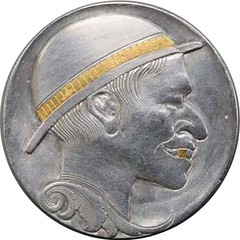 Banks/DelFavero: This modern carving depicts a clean shaven man wearing a domed hat and sporting a grin that shows off his bright gold tooth. Both the hatband with decorative vertical lines and the tooth are 24K gold inlays. The hair is composed of neatly engraved lines. A nicely shaped and detailed ear sits just below the hat brim. Modification to the Indian's profile (nose and mouth) adds character to the carving. Nice reduction of neck and decorative work across the collar. Finely brushed fields. Stamped SA on reverse. Eye catching carving.
Banks/DelFavero: This modern carving depicts a clean shaven man wearing a domed hat and sporting a grin that shows off his bright gold tooth. Both the hatband with decorative vertical lines and the tooth are 24K gold inlays. The hair is composed of neatly engraved lines. A nicely shaped and detailed ear sits just below the hat brim. Modification to the Indian's profile (nose and mouth) adds character to the carving. Nice reduction of neck and decorative work across the collar. Finely brushed fields. Stamped SA on reverse. Eye catching carving.

THE ERRORS ARE STILL OUT THERE
An article by Jason Kim in the December 2021 issue of ErrorScope from the Combined Organizations of Numismatic Error Collectors of America (CONECA) discusses a great junkbox find. With permission, we're republishing it here. Thanks to editor Allan Anderson for passing along the text and images. -Editor
Don't Give Up. The Errors Are Still Out There
By Jason Kim
I was at my local coin shop going through a junk bin of silver dimes. I had a list of dates I needed for my album and began to search. The mint marks on silver dimes appear on the back so I was flipping each coin checking for mintmarks. As I was flipping a Mercury dime, I noticed a peculiar ‘S mint mark. It looked different but I knew immediately what it was.
THE BOOK BAZARRE
THOUSAND-OUNCE SILVER ASSAY OFFICE INGOT
This Heritage press release describes an impressive 1949 silver ingot. -Editor
Unbelievable Thousand-Ounce Silver Assay Office Ingot Up For Bid
Heritage Auctions will be doing some heavy lifting in the January FUN Auction #1341 when an unbelievable 1949 silver ingot from the New York Assay Office crosses the auction block. This hefty piece of historical silver weighs 1016.46 Ounces and has to be seen to be believed!

QUARTER SHORTAGE IN SEATTLE
Coin shortages are still a thing. Here's an article about the tussle over quarters in Seattle. -Editor
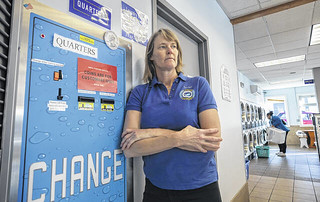 In the Before Times, Thorsen's Lunar Laundry, a coin-only laundromat in the Ballard neighborhood, was what's known as
In the Before Times, Thorsen's Lunar Laundry, a coin-only laundromat in the Ballard neighborhood, was what's known as quarter positive
: Customers brought in so many of their own coins that Thorsen made twice monthly coin deposits at her bank.
But soon after pandemic restrictions hit last year, Thorsen noticed customers relying more often on her change machine. Then noncustomers — apartment tenants and even some small-business owners — began coming in and surreptitiously draining her change machine.
As Lunar went quarter negative, Thorsen went to her bank to replenish her coin supply. But the bank was so short on change, she could only buy a few $10, 40-quarter rolls, and most often there were none at all. Where the heck are they going?
says Thorsen, who now spends considerable time moving her shrinking supply of quarters from her washers and dryers back to her change machine. It's not like they disappeared.
LOOSE CHANGE: DECEMBER 5, 2021
Here are some additional items in the media this week that may be of interest. -Editor
Bibliophiles should enjoy this New York Times item sent along by Len Augsburger - someone returned to an Idaho library a book that had been checked out in 1911. -Editor
In 1911, someone checked out a copy of the book New Chronicles of Rebecca
from a library in Boise, Idaho.
For the next 110 years, the city's libraries would survive pandemics, recessions and world wars — all without that copy of the 278-page series of stories by Kate Douglas Wiggin about an imaginative girl named Rebecca.
All that's known, she said, is that the book was returned either in late October or early November to a library in nearby Garden City. The librarians there sent the book to the main library in Boise because it still had inserts from an old library in the city that has since closed.
There have been other cases of books being returned decades overdue, but 110 years is an unusually long time. This year, a Wisconsin woman mailed a book that was 63 years overdue to the Queens Public Library in New York. In 2016, a 72-year-old Manhattan woman returned a book that was 57 years overdue.
To read the complete article, see:
After 110 Years, an Overdue Book Is Returned to a Library in Idaho
(https://www.nytimes.com/2021/11/30/us/overdue-book-idaho-library.html)
Other topics this week include a 1977-D Half Struck on a silver planchet, Free Coin Day, and the guy who got away with robbing a bank. -Editor

